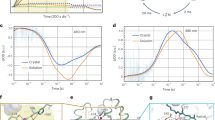Abstract
The very high mobility of protons in aqueous solutions demands special features of membrane proton transporters to sustain efficient yet regulated proton transport across biological membranes. By the use of the chemical energy of ATP, plasma-membrane-embedded ATPases extrude protons from cells of plants and fungi to generate electrochemical proton gradients. The recently published crystal structure of a plasma membrane H+-ATPase contributes to our knowledge about the mechanism of these essential enzymes. Taking the biochemical and structural data together, we are now able to describe the basic molecular components that allow the plasma membrane proton H+-ATPase to carry out proton transport against large membrane potentials. When divergent proton pumps such as the plasma membrane H+-ATPase, bacteriorhodopsin, and FOF1 ATP synthase are compared, unifying mechanistic premises for biological proton pumps emerge. Most notably, the minimal pumping apparatus of all pumps consists of a central proton acceptor/donor, a positively charged residue to control pK a changes of the proton acceptor/donor, and bound water molecules to facilitate rapid proton transport along proton wires.



Similar content being viewed by others
References
Auer M, Scarborough GA Kühlbrandt W (1998) Three-dimensional map of the plasma membrane H+-ATPase in the open conformation. Nature 392:840–843
Axelsen KB, Palmgren MG (1998) Evolution of substrate specificities in the P-type ATPase superfamily. J Mol Evol 46:84–101
Brandsburg-Zabary S, Fried O, Marantz Y, Nachliel E, Gutman M (2000) Biophysical aspects of intra-protein proton transfer. Biochim Biophys Acta 1458:120–134
Briskin DP, Hanson JB (1992) How does the plant plasma membrane H+-ATPase pump protons? J Exp Bot 43:269–289
Buch-Pedersen MJ, Palmgren MG (2003) Conserved Asp684 in transmembrane segment M6 of the plant plasma membrane P-type proton pump AHA2 is a molecular determinant of proton translocation. J Biol Chem 278:17845–17851
Buch-Pedersen MJ, Venema K, Serrano R, Palmgren MG (2000) Abolishment of proton pumping and accumulation in the E1P conformational state of a plant plasma membrane H+-ATPase by substitution of a conserved aspartyl residue in transmembrane segment 6. J Biol Chem 275:39167–39173
Capaldi RA, Aggeler R (2002) Mechanism of the F1FO-type ATP synthase, a biological rotary motor. Trends Biochem Sci 27:154–160
Copeland RA, Chan SI (1989) Proton translocation in proteins. Annu Rev Phys Chem 40:671–98
DeCoursey TE, Cherny VV (2000) Common themes and problems of bioenergetics and voltage-gated proton channels. Biochim Biophys Acta 1458:104–119
Eigen M (1964) Proton transfer acid–base catalysis and enzymatic hydrolysis. Angew Chem Int Ed 3:1–19
Elston T, Wang H, Oster G (1998) Energy transduction in ATP synthase. Nature 391:510–513
Fillingame RH, Angevine CM, Dmitriev OY (2003) Mechanics of coupling proton movements to c-ring rotation in ATP synthase. FEBS Lett 555:29–34
Garczarek F, Brown LS, Lanyi JK, Gerwert K (2005) Proton binding within a membrane protein by a protonated water cluster. Proc Natl Acad Sci USA 102:3633–3638
Gouaux E, Mackinnon R (2005) Principles of selective ion transport in channels and pumps. Science 310:1461–1465
Grigorieff N, Ceska TA, Downing KH, Baldwin JM, Henderson R (1998) Electron-crystallographic refinement of the structure of bacteriorhodopsin. J Mol Biol 259:393–421
Heberle J (2000) Proton transfer reactions across bacteriorhodopsin and along the membrane. Biochim Biophys Acta 1458:135–147
Lanyi JK (2004) Bacteriorhodopsin. Annu Rev Physiol 66:665–688
Mathias G, Marx D (2007) Structures and spectral signatures of protonated water networks in bacteriorhodopsin. Proc Natl Acad Sci USA 104:6980–6985
Morth JP, Pedersen BP, Toustrup-Jensen MS, Sørensen TL, Petersen J, Andersen JP, Vilsen B, Nissen P (2007) Crystal structure of the sodium–potassium pump. Nature 450:1043–1049
Neutze R, Pebay-Peyroula E, Edman K, Royant A, Navarro J, Landau EM (2002) Bacteriorhodopsin: a high-resolution structural view of vectorial proton transport. Biochim Biophys Acta 1565:144–167
Olesen C, Picard M, Winther AM, Gyrup C, Morth JP, Oxvig C, Møller JV, Nissen P (2007) The structural basis of calcium transport by the calcium pump. Nature 450:1036–1042
Palmgren MG (2001) Plant plasma membrane H+-ATPases: powerhouses for nutrient uptake. Annu Rev Plant Physiol Plant Mol Biol 52:817–845
Pardo JM, Serrano R (1989) Structure of a plasma membrane H+-ATPase gene from the plant Arabidopsis thaliana. J Biol Chem 264:8557–8562
Pedersen PL, Carafoli E (1987) Ion motive ATPases. 1. Ubuiquity properties and significance to cell-function. Trends Biochem Sci 12:146–150
Pedersen BP, Buch-Pedersen MJ, Morth JP, Palmgren MG, Nissen P (2007) Crystal structure of the plasma membrane proton pump. Nature 450:1111–1114
Pomes R, Roux B (2002) Molecular mechanism of H+ conduction in the single-file water chain of the gramicidin channel. Biophys J 82:2304–2316
Serrano R, Kielland-Brandt MC, Fink GR (1986) Yeast plasma-membrane ATPase is essential for growth and has homology with (Na+/K+), K+- and Ca2+-ATPases. Nature 319:689–693
Sørensen TL, Møller JV, Nissen P (2004) Phosphoryl transfer and calcium ion occlusion in the calcium pump. Science 304:1672–1675
Toyoshima C, Nakasako M, Nomura H, Ogawa H (2000) Crystal structure of the calcium pump of sarcoplasmic reticulum at 26 Å resolution. Nature 405:647–655
Toyoshima C, Nomura H, Tsuda T (2004) Lumenal gating mechanism revealed in calcium pump crystal structures with phosphate analogues. Nature 432:361–368
Zundel G (2000) Hydrogen bonds with large proton polarizability and proton transfer processes in electrochemistry and biology. Adv Chem Phys 111:1–218
Acknowledgments
M.J.B-P. is supported by a post-doctoral fellowship from the Carlsberg Foundation, B.P.P. by a Ph.D. fellowship from the Graduate School of Science at the University of Aarhus, and P.N. by a Hallas-Møller stipend from the Novo Nordisk Foundation.
Author information
Authors and Affiliations
Corresponding author
Rights and permissions
About this article
Cite this article
Buch-Pedersen, M.J., Pedersen, B.P., Veierskov, B. et al. Protons and how they are transported by proton pumps. Pflugers Arch - Eur J Physiol 457, 573–579 (2009). https://doi.org/10.1007/s00424-008-0503-8
Received:
Revised:
Accepted:
Published:
Issue Date:
DOI: https://doi.org/10.1007/s00424-008-0503-8




